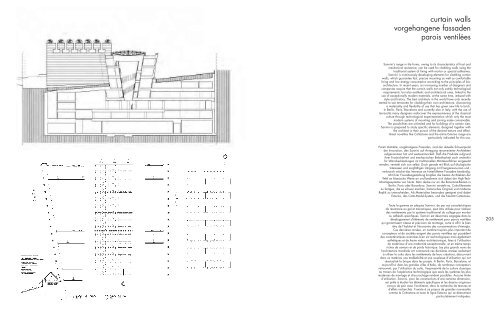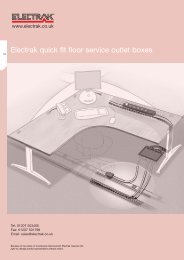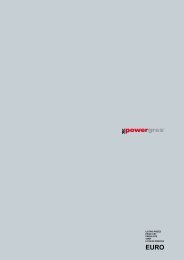by Stone & Sannini - EKA Group
by Stone & Sannini - EKA Group
by Stone & Sannini - EKA Group
Create successful ePaper yourself
Turn your PDF publications into a flip-book with our unique Google optimized e-Paper software.
curtain walls<br />
vorgehangene fassaden<br />
parois ventilées<br />
<strong>Sannini</strong>’s range in tile forms, owing to its characteristics of frost and<br />
mechanical resistance, can be used for cladding walls using the<br />
traditional system of fixing with mortar or special adhesives.<br />
<strong>Sannini</strong> is continuously developing elements for cladding curtain<br />
walls, which guarantee fast, precise mounting as well as comfortable<br />
living and low energy consumption according to the principles of bioarchitecture.<br />
In recent years, an increasing number of designers and<br />
companies require that the curtain walls not only satisfy technological<br />
requirements, but also aesthetic and architectural ones, linked to the<br />
use of exceptionally modern materials, at the same time, imbued with<br />
style and history. The best architects in the world have only recently<br />
started to use terracotta for cladding their own architecture, discovering<br />
a materiality and flexibility of use that has given new life to brick.<br />
In Berlin, Paris, Barcelona and currently also in Italy, with the use of<br />
terracotta many designers rediscover the expressiveness of the classical<br />
culture through technological experimentation which only the most<br />
modern systems of mounting and joining make conceivable.<br />
The possibilities are unlimited and for buildings of a certain size,<br />
<strong>Sannini</strong> is prepared to study specific elements, designed together with<br />
the architect in their pursuit of the desired texture and effect.<br />
Great novelties like Cottostone and the entire Externa range are<br />
particularly indicated for this use.<br />
Pareti Ventilate, vorgehangene Fassaden, sind der aktuelle Schwerpunkt<br />
der Innovation, den <strong>Sannini</strong> auf Anregung renommierter Architekten<br />
aufgenommen hat und weiterentwickelt. Daß die Produkte aufgrund<br />
ihrer Frostsicherheit und mechanischen Belastbarkeit auch weiterhin<br />
für Wandverkleidungen im traditionellen Mörtelverfahren eingesetzt<br />
werden, versteht sich von selbst. Doch gerade mit Blick auf ökologische<br />
Interessen und sorgfältigen Umgang mit Energieresourcen und -<br />
verbrauch wächst das Interesse an hinterlüfteten Fassaden beständig.<br />
Mit ihrer Fassadengestaltung knüpfen die besten Architekten der<br />
Welt an klassische Werte an und bedienen sich dabei der High-Tech-<br />
Montagesysteme von heute. Man denke nur an die Renommé-Bauten in<br />
Berlin, Paris oder Barcelona. <strong>Sannini</strong> versteht es, Cotto-Elemente<br />
zu fertigen, die es schwer machen, historisches Original und moderne<br />
Replik zu unterscheiden. Als Materialien besonders geeignet sind dabei<br />
Externa, das Cotto-Modul-System, und die Novität Cottostone.<br />
Toute la gamme en plaques <strong>Sannini</strong>, de par ses caractéristiques<br />
de résistance au gel et mécaniques, peut être utilisée pour réaliser<br />
des revêtements par le système traditionnel du collage par mortier<br />
ou adhésifs spécifiques. <strong>Sannini</strong> est désormais engagée dans le<br />
développement d’éléments de revêtement pour parois ventilées<br />
qui garantissent vitesse et précision de montage, outre à offrir le bien<br />
être de l’habitat et l’économie des consommations d’énergie.<br />
Ces dernières années, un nombre toujours plus important de<br />
concepteurs et de sociétés exigent des parois ventilées qui possèdent<br />
des caractéristiques avancées bien sûr technologiques mais également<br />
esthétiques et de haute valeur architectonique, liées à l’utilisation<br />
de matériaux d’une modernité exceptionnelle et en même temps<br />
riches de saveurs et de poids historique. Les plus grands noms de<br />
l’architecture mondiale ont commencé ces dernières années seulement<br />
à utiliser le cotto dans les revêtements de leurs créations, découvrant<br />
dans ce matériau une malléabilité et une souplesse d’utilisation qui ont<br />
réactualisé la brique dans les projets. A Berlin, Paris, Barcelone, et<br />
aujourd’hui dans les grandes villes d’Italie, de nombreux concepteurs<br />
retrouvent, par l’utilisation du cotto, l’expressivité de la culture classique<br />
au travers de l’expérience technologique que seuls les systèmes les plus<br />
modernes de montage et d’accrochage rendent possibles. Aucune limite<br />
d’utilisation. <strong>Sannini</strong>, pour les constructions d’une certaine dimension,<br />
est prête à étudier les éléments spécifiques et les dessins originaux<br />
conçus de pair avec l’architecte, dans la recherche de textures et<br />
d’effets recherchés. Il existe à ce propos de grandes nouveautés<br />
comme le Cottostone et toute la ligne Externa qui se démontrent<br />
particulièrement indiquées.<br />
205





